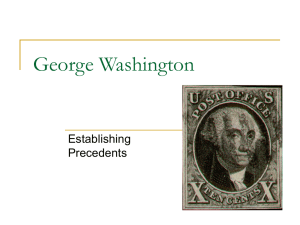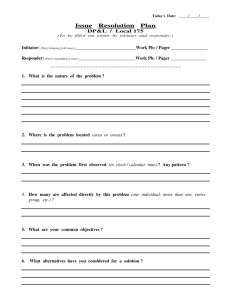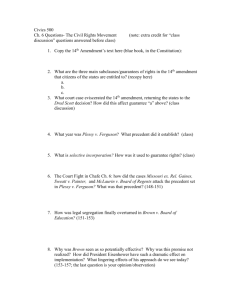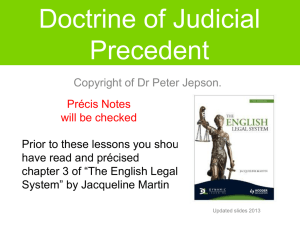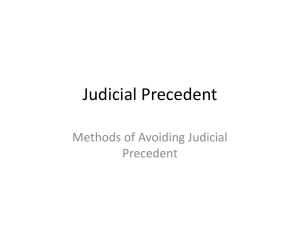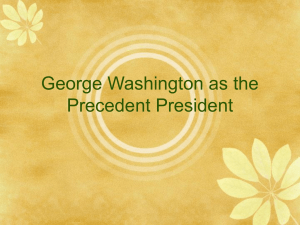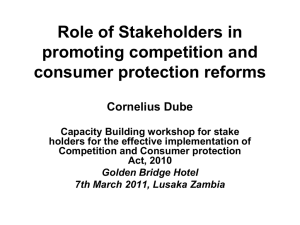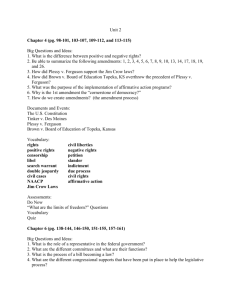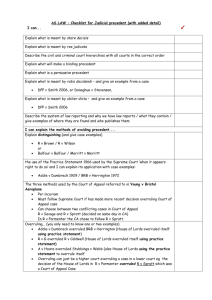Precedent and Citizens United v. FEC
advertisement
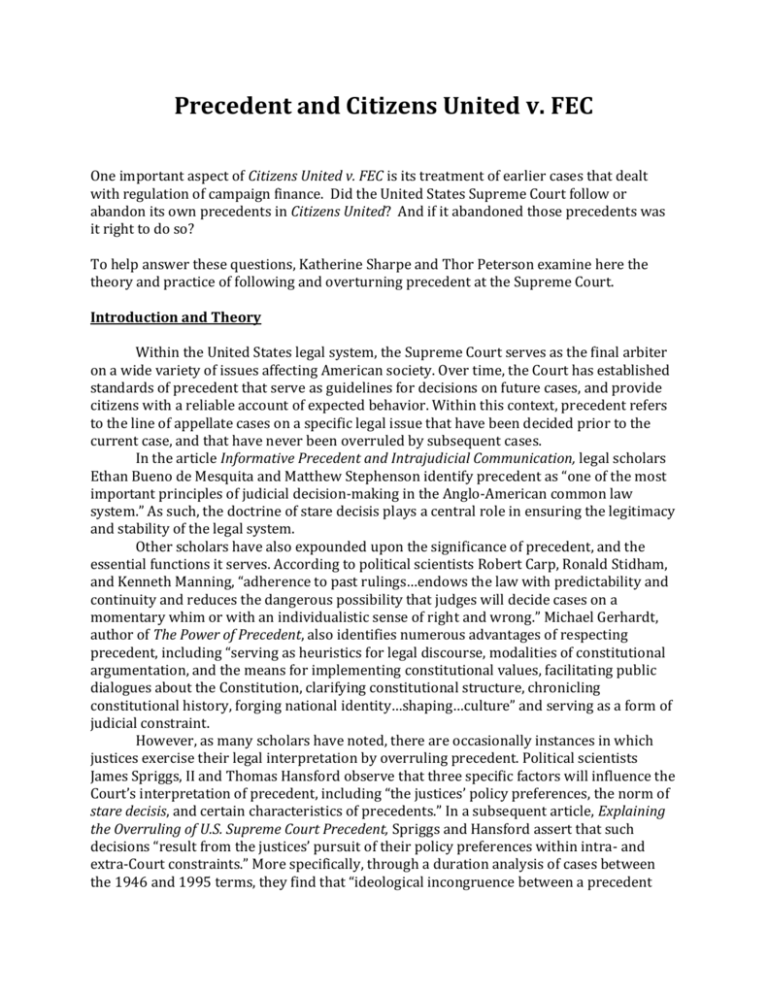
Precedent and Citizens United v. FEC One important aspect of Citizens United v. FEC is its treatment of earlier cases that dealt with regulation of campaign finance. Did the United States Supreme Court follow or abandon its own precedents in Citizens United? And if it abandoned those precedents was it right to do so? To help answer these questions, Katherine Sharpe and Thor Peterson examine here the theory and practice of following and overturning precedent at the Supreme Court. Introduction and Theory Within the United States legal system, the Supreme Court serves as the final arbiter on a wide variety of issues affecting American society. Over time, the Court has established standards of precedent that serve as guidelines for decisions on future cases, and provide citizens with a reliable account of expected behavior. Within this context, precedent refers to the line of appellate cases on a specific legal issue that have been decided prior to the current case, and that have never been overruled by subsequent cases. In the article Informative Precedent and Intrajudicial Communication, legal scholars Ethan Bueno de Mesquita and Matthew Stephenson identify precedent as “one of the most important principles of judicial decision-making in the Anglo-American common law system.” As such, the doctrine of stare decisis plays a central role in ensuring the legitimacy and stability of the legal system. Other scholars have also expounded upon the significance of precedent, and the essential functions it serves. According to political scientists Robert Carp, Ronald Stidham, and Kenneth Manning, “adherence to past rulings…endows the law with predictability and continuity and reduces the dangerous possibility that judges will decide cases on a momentary whim or with an individualistic sense of right and wrong.” Michael Gerhardt, author of The Power of Precedent, also identifies numerous advantages of respecting precedent, including “serving as heuristics for legal discourse, modalities of constitutional argumentation, and the means for implementing constitutional values, facilitating public dialogues about the Constitution, clarifying constitutional structure, chronicling constitutional history, forging national identity…shaping…culture” and serving as a form of judicial constraint. However, as many scholars have noted, there are occasionally instances in which justices exercise their legal interpretation by overruling precedent. Political scientists James Spriggs, II and Thomas Hansford observe that three specific factors will influence the Court’s interpretation of precedent, including “the justices’ policy preferences, the norm of stare decisis, and certain characteristics of precedents.” In a subsequent article, Explaining the Overruling of U.S. Supreme Court Precedent, Spriggs and Hansford assert that such decisions “result from the justices’ pursuit of their policy preferences within intra- and extra-Court constraints.” More specifically, through a duration analysis of cases between the 1946 and 1995 terms, they find that “ideological incongruence between a precedent and a subsequent Court increases the chance of it being overruled,” and that in accordance with legal norms, “the Court is less likely to overrule statutory precedents and more likely to overrule precedents that previously have been interpreted negatively by the Court.” Through an examination of past court opinions, Gerhardt also observes that the most common explanations for the Court’s overruling of precedent include inconsistency with later precedents, the case being decided incorrectly, unworkability, and altered circumstances. Bueno de Mesquita and Stephenson argue that ultimately, “justices care about precedent precisely because they care about policy,” and that if a justice “decides that the additional accuracy” of maintaining a long standing ruling “is not worth the sacrifice in terms of substantive policy,” then he or she will vote to break with precedent. Such an evaluation is reflected in an opinion of Justice Anthony Kennedy written in 1989: “Our precedents are not sacrosanct, for we have overruled prior decisions where the necessity and propriety of doing so has been established…Nonetheless, we have held that ‘any departure from the doctrine of stare decisis demands special justification.’” While such changes occur relatively infrequently, Spriggs and Hansford affirm that the overruling of precedent is significant because it represents a “dramatic form” of change that “potentially influence social, political, and economic relations as actors alter their behavior based on the new legal rule.” The cases that follow are intriguing examples of overruling precedent, and appear to confirm these theories about what factors contribute to the likelihood of a decision being overturned. Legal Cases Freedom of Speech Adler v. Board of Education (1952) Overturned by: Keyishian v. Board of Regents of the University of the State of New York (1967) In the 1950’s the state of New York enacted a law that permitted public schools to fire teachers that belonged to “subversive organizations.” The state teacher’s union instructed teachers to not answer questions regarding their loyalty to the U.S. and any connection with the Communist party. However the teachers that refused to participate were then fired. This resulted in the union suing the state board of education. Ultimately, the Supreme Court ruled that the law firing teachers was neither too vague nor in violation of freedom of speech or due process. In the 1960’s professor Harry Keyishian and a number of his colleagues at the State University of New York similarly refused certify that they were not Communists and were either fired or compelled to resign. This resulted in the case of Keyishian v. Board of Regents of the University of the State of New York. Faculty members of the university brought this action for declaratory and injunctive relief, arguing that New York’s teacher loyalty laws and regulations were unconstitutional. In the opinion of the Court, Justice Brennan acknowledged the standing precedent, noting that: We considered some aspects of the constitutionality of the New York plan 15 years ago in Adler v. Board of Education, 342 U.S. 485. That litigation arose after New York passed the Feinberg Law, which added 3022 to the Education Law. The Feinberg Law was enacted to implement and enforce two earlier statutes. The first was a 1917 law, now 3021 of the Education Law, under which "the utterance of any treasonable or seditious word or words or the doing of any treasonable or seditious act" is a ground for dismissal from the public school system. The second was a 1939 law which was 12-a of the Civil Service Law when Adler was decided and, as amended, is now 105 of that law. This law disqualifies from the civil service and from employment in the educational system any person who advocates the overthrow of government by force, violence, or any unlawful means, or publishes material advocating such overthrow, or organizes or joins any society or group of persons advocating such doctrine. Yet in response to this decision, the justices argue that: There can be no doubt of the legitimacy of New York's interest in protecting its education system from subversion. But even though the governmental purpose be legitimate and substantial, that purpose cannot be pursued by means that broadly stifle fundamental personal liberties when the end can be more narrowly achieved. Therein lies the security of the Republic, the very foundation of constitutional government. Our Nation is deeply committed to safeguarding academic freedom, which is of transcendent value to all of us, and not merely to the teachers concerned. That freedom is therefore a special concern of the First Amendment, which does not tolerate laws that cast a pall of orthodoxy over the classroom. "The vigilant protection of constitutional freedoms is nowhere more vital than in the community of American schools." Shelton v. Tucker, supra at 487. The classroom is peculiarly the "marketplace of ideas." The Nation's future depends upon leaders trained through wide exposure to that robust exchange of ideas which discovers truth "out of a multitude of tongues, [rather] than through any kind of authoritative selection." A law which applies to membership without the "specific intent" to further the illegal aims of the organization infringes unnecessarily on protected freedoms. It rests on the doctrine of "guilt by association," which has no place here. Thus, the Supreme Court overturned its previous decision, and stated that the law was too vague to be constitutional and that it represented the suppression of free speech and academic freedom. This represents a reinterpretation of the application of constitutional values, and a significant overruling of precedent. Civil Rights Pace v. Alabama (1883) Overturned by: Loving v. Virginia (1967) During this time, the state of Alabama upheld anti-miscegenation laws that forbade intimate relations or marriage between African-Americans and whites. Tony Pace, an African-American man, was dating a white woman, and after being found in violation of the law, appealed the case to the Supreme Court. Yet the Court held that the state had a valid interest in defending the institution of marriage, and was therefore not acting unconstitutionally. However a similar issue arose in 1958 when two residents of Virginia, Mildred Jeter and Richard, entered into an interracial marriage in the District of Colombia. Yet after returning to Virginia, the couple was charged with violating the state’s ban on interracial marriage. In 1967 in the case of Loving v. Virginia, the Supreme Court unanimously decided that laws of this nature had no legal standing, and represented state-sponsored racism. In the Court’s opinion issued by Justice Warren: The fact that Virginia prohibits only interracial marriages involving white persons demonstrates that the racial classifications must stand on their own justification, as measures designed to maintain White Supremacy. [n11] We have consistently denied [p12] the constitutionality of measures which restrict the rights of citizens on account of race. There can be no doubt that restricting the freedom to marry solely because of racial classifications violates the central meaning of the Equal Protection Clause. These statutes also deprive the Lovings of liberty without due process of law in violation of the Due Process Clause of the Fourteenth Amendment. The freedom to marry has long been recognized as one of the vital personal rights essential to the orderly pursuit of happiness by free men. Thus, this ruling overruled the Virginia law against interracial marriage and rendered all similar laws invalid, on the basis of ideological incongruences between the precedent and the subsequent court. Plessy v. Ferguson (1896) Overturned by: Brown v. Board of Education (1954) In the case Plessy v. Ferguson, Homer Plessy had 1/8th black ancestry, and although Louisiana has laws establishing separate facilities for blacks, his light skin generally allowed him to ride in the white sections of trains. At this time, he was chosen by the Citizen’s Committee to Test the Constitutionality of the Separate Car Law, and was subsequently arrested after announcing his ancestry on a train and refusing to move to the black section. However, at the time the Supreme Court ruled that such laws were not a constitutional violation. This ruling sustained the legal doctrine of “separate but equal” in the U.S. for over 50 years. However in 1951, a class action suit was filed against the Board of Education of the City of Topeka, Kansas in the US District Court for the District of Kansas. Thirteen parents, who had attempted to enroll their twenty children in a segregated school near their homes, fought against the denial of admission. Ultimately, this case was taken the to the Supreme Court, which emphasized the responsibility of state and local governments to provide the opportunity of an education for all children on an equal basis. In the opinion, the majority stated: We come then to the question presented: Does segregation of children in public schools solely on the basis of race, even though the physical facilities and other "tangible" factors may be equal, deprive the children of the minority group of equal educational opportunities? We believe that it does. We conclude that, in the field of public education, the doctrine of "separate but equal" has no place. Separate educational facilities are inherently unequal. Therefore, we hold that the plaintiffs and others similarly situated for whom the actions have been brought are, by reason of the segregation complained of, deprived of the equal protection of the laws guaranteed by the Fourteenth Amendment. Thus, the Supreme Court ruled in the case of Brown v. Board of Education that “separate but equal” was unconstitutional, and banned racial segregation. Due Process Wolf v. Colorado (1949) Overturned by: Mapp v. Ohio (1961) In 1949 Dr. Julius Wolf was found guilty of performing illegal abortions, but argued that the evidence used against him had been illegally seized. The Supreme Court ruled against Wolf, and decided that the exclusionary rule, regarding improper search and seizure, did not apply to the states. Subsequently, in the 1961 case of Mapp v. Ohio, the Court examined a situation in which authorities search Dollree Mapp’s house for a suspected fugitive with no proof of a legitimate warrant, and later convicted her of obscenity based on “lewd and lascivious books, pictures, and photographs,” found in her home. However, the majority of the court concluded that: Our holding that the exclusionary rule is an essential part of both the Fourth and Fourteenth Amendments is not only the logical dictate of prior cases, but it also makes very good sense. There is no war between the Constitution and common sense. Presently, a federal prosecutor may make no use of evidence illegally seized, but a State's attorney across the street may, although he supposedly is operating under the enforceable prohibitions of the same Amendment. Thus, the State, by admitting evidence unlawfully seized, serves to encourage disobedience to the Federal Constitution which it is bound to uphold. Justice Black also concurred with the overruling of Wolf, even though he had previously concurred with that case, because “the continued existence of mutually inconsistent precedents together with the Court’s inability to settle upon a [standard for determining when illegally seized evidence could not be admitted in state prosecutions] left the situation at least as uncertain as it had been before.” Thus, the majority found that the preceding case was contradictory to the Court’s new interpretation, and overturned the standing decision regarding the exclusionary rule Labor Laws Lochner v. New York (1905); Adkins v. Children’s Hospital (1923) Overturned by: West Coast Hotel Co. v. Parrish (1937) The Lochner case regarded New York’s Bakeshop Act, a statute that limited the time baker employees could work to 60 hours per week or 10 hours per day. Lochner was convicted of breaking this statute after allowing an employee to work more hours. The question before the Court was whether states have the right to restrict contracts under the Due Process Clause of the Fourteenth Amendment. Writing for the majority, Justice Peckham found that a state could only restrict contracts in such cases as have a direct relation to the welfare and health of the employee. In this case, Peckham found, there was not reasonable ground for interfering with the baker’s Fourteenth Amendment right to form contracts. Similarly, in Adkins, the District of Columbia set a law dictating minimum wages for women and children. The Court found that this law violated Fourteenth Amendment rights to set contracts and was overly vague. Justice Sutherland objected to Congress simply enacting a “price-fixing law.” The two previous cases were overturned by the Court’s decision in West Coast Hotel Co. v. Parrish (1937). Elsie Parrish was receiving sub-minimum wage from the West Coast Hotel Company and sued for the difference. In the majority opinion, Justice Hughes defends the need to consider overturning precedent in this case: The importance of the question, in which many States having similar laws are concerned, the close division by which the decision in the Adkins case was reached, and the economic conditions which have supervened, and in the light of which the reasonableness of the exercise of the protective power of the State must be considered, make it not only appropriate, but we think imperative, that, in deciding the present case, the subject should receive fresh consideration. Justice Hughes and the majority held that the establishment of minimum wages for women was constitutional. The Court found that the Constitution does not speak of preserving contracts and that liberty is subject to the restraints of the due process clause. Further, contracts are not equal between employers and employees, especially in the case of women. Changing national circumstances and norms heavily influenced this precedent reversal. Justice Hughes references the Great Depression as creating a national landscape in which employee protection is necessary and argues that numerous states had instituted similar minimum wage statutes. Gay Rights Bowers v. Hardwick (1986) Overturned by: Lawrence v. Texas (2003) Michael Hardwick was observed engaging in private, consensual homosexual acts of sodomy by a police officer in Georgia, where sodomy was a felony. Hardwick challenged the constitutionality of the law, claiming that it limited the sexual freedom of homosexuals. The Court found that the Constitution did not protect acts of sodomy; only those rights that are “implicit in the concept of ordered liberty” or “deeply rooted in the Nation’s traditions and history” can be protected by the Court. Similarly, a Texas police officer investigating errant leads relating to gun charge found Lawrence engaging in homosexual relations and charged him with “deviant sexual intercourse.” The question before the court was whether a statute making homosexual relations a crime violated the Due Process Clause. The Court found that such a statute did, in fact, violate the Constitution. Writing for the majority, Justice Kennedy argued that the Constitution defends the personal liberty of autonomy. Sexual decisions are both private and personal—a state may not intrude on such a decision. In breaking precedent, Justice Kennedy argued: The historical grounds relied upon in Bowers are more complex than the majority opinion and the concurring opinion by Chief Justice Burger indicate. Their historical premises are not without doubt and, at the very least, are overstated…. The issue is whether the majority may use the power of the State to enforce [moral and religious views] on the whole society through operation of the criminal law.” Kennedy’s answer is a definitive “no.” Changing national views on homosexuality and the role of personal morals in national law precipitated this departure from precedent. Campaign Financing Austin v. Michigan Chamber of Commerce (1990); McConnell v. Federal Election Commission (2003) Overturned by: Citizens United v. Federal Election Commission (2010) The Michigan Campaign Finance Act prohibited corporations from using general treasury funds for campaign contributions, but did allow companies to set up separate political funds, expressly for that purpose. The Michigan Chamber of Commerce wanted to support a candidate for Michigan’s House of Representatives using funds from its general treasury. The Chamber of Commerce had two arguments: (1) it should be excluded from the restrictions because it was a “nonprofit ideological corporation” and (2) that the law limited First Amendment rights of speech, press, and assembly. Justice Marshall, writing for the majority, found that the statute did apply to the Chamber because it was mostly comprised of business corporations and that the statute was narrowly crafted and implemented to ensure liberty in the campaign process. When the Bipartisan Campaign Finance Reform Act of 2002 was passed, it contained a provision providing for an early federal trial and direct appeal to the Supreme Court. The questions before the Court were (1) whether the Reform Act’s provision against unregulated donations by corporations exceeded Congress’ ability to regulate elections under Article 1, Section 4 of the Constitution or First Amendment freedom of speech rights and (2) whether regulations of the source, content or timing of political advertising by corporations violated First Amendment rights. The Court found, generally, no to both questions. The majority opinion, written by Justices Sandra Day O’Connor and John Paul Stevens found that, because the restrictions dealt mostly with “soft money,” the restriction of the freedom of speech was minimal. Also, the law only applied to states in which federal elections were being conducted, so Congress did not overstep the Article 1 powers. Citizens United v. Federal Election Commission (2010) overturned both of the previous cases. Citizens United sought an injunction against the FEC to allow Citizens to produce its film Hillary: The Movie, a documentary expressing concerns that Senator Hillary Rodham Clinton would not make a good president. Citizens United argued that the Bipartisan Campaign Reform Act was unconstitutional on two grounds. First, that the section preventing corporations or labor unions from funding electioneering communications with general treasury funds violates the First Amendment. Second, the section requiring the disclosure of donors to the communication and a disclaimer when a candidate it intends to support does not authorize the communication is unconstitutional as applied to the circumstances. The majority opinion, written by Justice Kennedy, answered four questions in this case. First, the Court’s decision in McConnel did not resolve all constitutional as-applied challenges to the Reform Act. Second, the Act’s disclosure requirements did not unconstitutionally burden corporations on First Amendment grounds. Third, a communication that lacks a clear plea to vote for or against a candidate is still subject to the Reform Act. Fourth, a full-length film should be treated as a campaign advertisement under the Act. However, the majority found that political speech is indispensable to democracy, and thus should not be restricted for corporations. Justice Kennedy made many important claims regarding precedence in his majority opinion. First, he notes that, in this case, precedence has already been broken: “The Court is thus confronted with conflicting lines of precedent: a pre-Austin line that forbids restrictions on political speech based on the speaker’s corporate identity and a post-Austin line that permits them.” He then launches into an exploration of when it is appropriate to ignore stare decisis: Our precedent is to be respected unless the most convincing of reasons demonstrates that adherence to it puts us on a course that is sure error. ‘Beyond workability, the relevant factors in deciding whether to adhere to the principle of stare decisis include the antiquity of the precedent, the reliance interests at stake, and of course whether the decision was well reasoned.’ Montejo v. Louisiana (2009). We have also examined whether ‘experience has pointed up the precedent’s shortcomings.’ Pearson v. Callahan(2009). These considerations counsel in favor of rejecting Austin, which itself contravened this Court’s earlier precedents in Buckley and Bellotti. ‘This Court has not hesitated to overrule decisions offensive to the First Amendment.’ WRTL, 551 U. S., at 500 (opinion of SCALIA, J.). “[S]tare decisis is a principle of policy and not a mechanical formula of adherence to the latest decision.” Helvering v. Hallock (1940). Justice Kennedy cites the following reasons to break precedent in this case: When neither party defends the reasoning of a precedent, the principle of adhering to that precedent through stare decisis is diminished. Austin abandoned First Amendment principles…. Austin is undermined by experience since its announcement. Political speech is so ingrained in our culture that speakers find ways to circumvent campaign finance laws. Slavery Dred Scott v. Sandford (1857) Overturned by: Thirteenth (1865) and Fourteenth (1868) Amendments Dred Scott was a slave from Missouri, who lived in Illinois (a free state) in an area of the Louisiana territory (where slavery was forbidden by the the Louisiana Compromise of 1820). Upon returning to Missouri, Scott sued for his freedom, claiming that he had been a resident of a free state, so was a free man. Writing for the majority, Justice Taney found that no one but a citizen of the United States could be a citizen of a state and only Congress could confer citizenship. No person of African-American descent could be considered a citizen under Article III of the Constitution, so Scott was never a citizen of Illinois. Further, the Court declared the Louisiana Compromise unconstitutional, hoping to end the debate on slavery. This case was not actually overturned by a Court decision, but was reversed by the Thirteenth Amendment, which banned slavery, and the Fourteenth Amendment, which stated that all people born in the United States are citizens. Though this is not an example of the Supreme Court rejecting stare decisis, it is an important example of how the Court’s word is not always final. Concluding Thoughts The cases above illustrate the active processes of the United States legal system that allow Supreme Court justices to re-evaluate issues as they become pertinent in American society. Although the overruling of cases has proved to be a relatively rare occurrence, the scope of the Court’s docket has expanded in recent years. As noted by Gerhardt, the harder reconciling cases becomes, the more pressure there may be for overturning precedent. However, it is also possible that justices may opt to weaken precedent by narrowly constructing interpretations of contentious cases, without formally declaring them overruled. According to Gerhardt, this has become even more evident in the “Court’s widely reported and criticized shift since 1995 to limit congressional power to regulate private activity under the commerce clause.” Yet he also identifies the existence of “super precedents” which are constitutional decisions repeatedly approved over time, and have therefore become “deeply and irrevocably embedded in national consciousness.” Such considerations of precedent are a testament to the dynamic and fascinating power of the United States Supreme Court.
